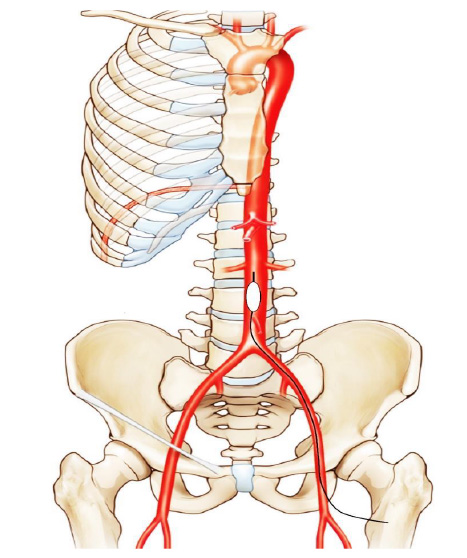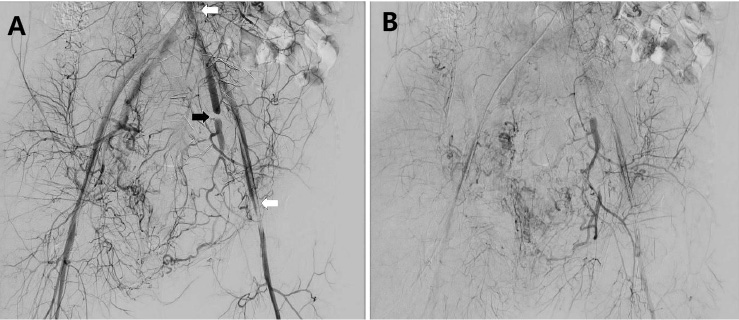Perinatology.
2019 Sep;30(3):175-178. 10.14734/PN.2019.30.3.175.
Intraoperative Use of Resuscitative Endovascular Balloon Occlusion of the Aorta for Hemorrhage Control in Woman with Placenta Percreta Involving the Bladder
- Affiliations
-
- 1Department of Thoracic and Cardiovascular Surgery, Dankook University Hospital, Cheonan, Korea.
- 2Department of General Surgery, Trauma Center, Dankook University Hospital, Cheonan, Korea.
- 3Department of Obstetrics and Gynecology, Dankook University Hospital, Cheonan, Korea. soo8541@hanmail.net
- KMID: 2460032
- DOI: http://doi.org/10.14734/PN.2019.30.3.175
Abstract
- A 42-year-old woman with irregular uterine contractions and a history of two prior cesarean sections was admitted. At 35 weeks of gestation, preterm labor with vaginal bleeding led to a cesarean section. During placenta removal it was revealed to be a percreta and uncontrollable massive bleeding ensued. Intraoperative resuscitative endovascular balloon occlusion of the aorta (REBOA) was performed, which has been used as a resuscitative adjunct for trauma patients with noncompressible torso hemorrhage and a hysterectomy was successfully completed. Gauze packing for temporary abdominal closure and angio-embolization were performed to further control bleeding. The packed gauze was removed 2 days later and the patient recovered uneventfully. To the best of our knowledge, this is the first reported case in South Korean literature of the successful application of a REBOA as a salvage treatment for hemorrhage control, and REBOA could be a life-saving procedure for patients with peripartum hemorrhaging.
MeSH Terms
Figure
Cited by 1 articles
-
Postpartum Hemorrhage
Su Jin Lee, Yun Dan Kang
J Korean Soc Matern Child Health. 2022;26(4):225-233. doi: 10.21896/jksmch.2022.26.4.225.
Reference
-
1. Wu S, Kocherginsky M, Hibbard JU. Abnormal placentation: twenty-year analysis. Am J Obstet Gynecol. 2005; 192:1458–1461.
Article2. Parra MW, Ordonez CA, Herrera-Escobar JP, Gonzalez-Garcia A, Guben J. Resuscitative endovascular balloon occlusion of the aorta for placenta percreta/previa. J Trauma Acute Care Surg. 2018; 84:403–405.
Article3. Cali G, Forlani F, Giambanco L, Amico ML, Vallone M, Puccio G, et al. Prophylactic use of intravascular balloon catheters in women with placenta accreta, increta and percreta. Eur J Obstet Gynecol Reprod Biol. 2014; 179:36–41.
Article4. Ballas J, Hull AD, Saenz C, Warshak CR, Roberts AC, Resnik RR, et al. Preoperative intravascular balloon catheters and surgical outcomes in pregnancies complicated by placenta accreta: a management paradox. Am J Obstet Gynecol. 2012; 207:216.e1–216.e5.5. Stannard A, Eliason JL, Rasmussen TE. Resuscitative endovascular balloon occlusion of the aorta (REBOA) as an adjunct for hemorrhagic shock. J Trauma. 2011; 71:1869–1872.
Article6. Kim DH, Chang SW, Matsumoto J. The utilization of resuscitative endovascular balloon occlusion of the aorta: preparation, technique, and the implementation of a novel approach to stabilizing hemorrhage. J Thorac Dis. 2018; 10:5550–5559.
Article7. Brennan DJ, Schulze B, Chetty N, Crandon A, Petersen SG, Gardener G, et al. Surgical management of abnormally invasive placenta: a retrospective cohort study demonstrating the benefits of a standardized operative approach. Acta Obstet Gynecol Scand. 2015; 94:1380–1386.
Article8. Manzano-Nunez R, Escobar-Vidarte MF, Naranjo MP, Rodriguez F, Ferrada P, Casallas JD, et al. Expanding the field of acute care surgery: a systematic review of the use of resuscitative endovascular balloon occlusion of the aorta (REBOA) in cases of morbidly adherent placenta. Eur J Trauma Emerg Surg. 2018; 44:519–526.
Article9. Ordonez CA, Manzano-Nunez R, Parra MW, Rasmussen TE, Nieto AJ, Herrera-Escobar JP, et al. Prophylactic use of resuscitative endovascular balloon occlusion of the aorta in women with abnormal placentation: a systematic review, meta-analysis, and case series. J Trauma Acute Care Surg. 2018; 84:809–818.
Article10. Wu Q, Liu Z, Zhao X, Liu C, Wang Y, Chu Q, et al. Outcome of pregnancies after balloon occlusion of the infrarenal abdominal aorta during caesarean in 230 patients with placenta praevia accreta. Cardiovasc Intervent Radiol. 2016; 39:1573–1579.
Article11. Ogura T, Lefor AK, Nakamura M, Fujizuka K, Shiroto K, Nakano M. Ultrasound-guided resuscitative endovascular balloon occlusion of the aorta in the resuscitation area. J Emerg Med. 2017; 52:715–722.
Article12. Matsumura Y, Matsumoto J, Kondo H, Idoguchi K, Ishida T, Kon Y, et al. Fewer REBOA complications with smaller devices and partial occlusion: evidence from a multicentre registry in Japan. Emerg Med J. 2017; 34:793–799.
Article13. Pezy P, Flaris AN, Prat NJ, Cotton F, Lundberg PW, Caillot JL, et al. Fixed-distance model for balloon placement during fluoroscopy-free resuscitative endovascular balloon occlusion of the aorta in a civilian population. JAMA Surg. 2017; 152:351–358.
Article14. Johnson MA, Neff LP, Williams TK, DuBose JJ. EVAC Study Group. Partial resuscitative balloon occlusion of the aorta (P-REBOA): clinical technique and rationale. J Trauma Acute Care Surg. 2016; 81(5 Suppl 2 Proceedings of the 2015 Military Health System Research Symposium):S133–S137.15. Qasim Z, Brenner M, Menaker J, Scalea T. Resuscitative endovascular balloon occlusion of the aorta. Resuscitation. 2015; 96:275–279.
Article
- Full Text Links
- Actions
-
Cited
- CITED
-
- Close
- Share
- Similar articles
-
- Successful management of uncontrolled postpartum hemorrhage due to morbidly adherent placenta with Resuscitative endovascular balloon occlusion of the aorta during emergency cesarean section - A case report -
- A Case of Placenta Percreta Involving the Urinary Bladder
- Positioning of Resuscitative Endovascular Balloon Occlusion of the Aorta Catheter: A Case of an Elderly Patient with Concomitant Chest and Pelvic Injury after Blunt Trauma
- Resuscitative Endovascular Balloon Occlusion of the Aorta in a Trauma Patient with Hypovolemic Shock
- Transsplenic Ultrasound-Guided Balloon Positioning During a Zone 1 Resuscitative Endovascular Balloon Occlusion of the Aorta: A Case Report



